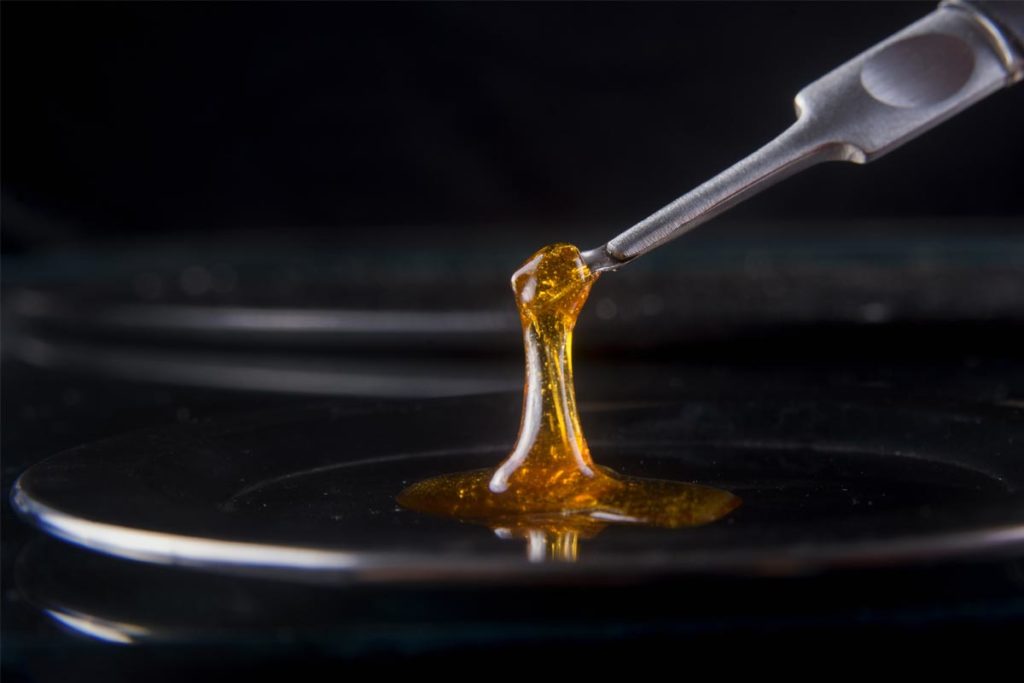By Nathan Falde The practice of dabbing, which involves the inhalation of marijuana vapors in a highly concentrated form, is revolutionizing the concept of marijuana intoxication. While smoking pot in the traditional way delivers a relatively mild high, dabbing is catching on because it does precisely the opposite.
The ABCs of Dabbing
When marijuana plants are soaked in a solvent such as butane or carbon dioxide, and then heated and pressurized, much of the raw plant material is melted away until all that is left is a gooey, waxy, gummy lump of chemical extract. Most prominent among the conglomeration of remaining substances is THC (tetrahydrocannabinol), the psychoactive ingredient in marijuana responsible for its mind-altering effects. While THC in “normal” marijuana is present at concentrations of about 20%, in small chunks (dabs) of concentrated cannabis THC density rises to 80% or more. Needless to say when this product is consumed, it packs quite the wallop in comparison to traditional marijuana. When used recreationally, dabs are inserted in glass bongs, electronic cigarettes, vaporizers, vape pens or specially manufactured dabbing devices. Heat is applied and as the dab vaporizes, it is inhaled, causing an immediate physical effect that can be so powerful it has been known to cause unconsciousness. In states where medical marijuana is legal, commercial enterprises produce dabs of concentrated cannabis under safe, controlled conditions, often using volatile butane as a solvent. In this form butane hash oil or BHO, as the extract is often called, can deliver rapid and enhanced pain-relieving effects, making it popular with men and women who’ve been prescribed cannabis products for their illnesses. With medical and/or recreational marijuana now legally available in many states, it is not surprising that products sold in those locations would be diverted onto the black market (illicit drug dealers are nothing if not resourceful). The creation of this illegal market has made it relatively easy for interested parties to obtain dabs (also known on the street as shatter, wax, budder or honey, among other nicknames) for purposes that have nothing to do with relieving physical pain. But as demand for dabs has increased, home entrepreneurs have also gotten into the act. For these aspiring drug retailers, butane is the overwhelming solvent of choice, mainly because it is cheap and widely available. Unfortunately, it is also toxic and explosive, and with the lack of quality control in DIY manufacturing explosions, fires and serious injuries in home dab labs are fairly common. Home-brewed marijuana products are often contaminated with impurities as well, and people purchasing these cheap knockoffs have no idea what kind of poisons they might be inhaling in addition to highly concentrated THC.
Side Effects of Concentrated Marijuana Consumption
Regardless of the source, BHO is a potent substance that produces powerful neurological effects. In its impact, it can mimic stronger drugs like methamphetamine, LSD, Ecstasy or DMT, and if users didn’t know the truth, it would never dawn on them that they were actually experiencing the effects of marijuana in a more intense manifestation. Dabbing unleashes the hidden potential of THC, which can slam users with the force of the proverbial 10-ton Mack truck. Marijuana won’t do that in its more common herbal form, but when distilled to purity it transforms into a drug capable of creating debilitating side effects, including:
- Profuse sweating
- Dizziness
- Rapid heartbeat
- Anxiety
- Paranoia
- Hallucinations
- Blackouts
- Psychotic breaks with reality
In addition to these physical and psychological effects, dabbing appears to be far more addictive than typical marijuana consumption, although this conclusion is based largely on anecdotal evidence rather than controlled scientific study. Dabbing has actually been around since the 1970s, but until recently it was a subculture practice unfamiliar to most drug aficionados. But with medical and recreational legalization sweeping the country, it was inevitable that a wider range of people would be exposed to concentrated marijuana products. And thanks to the proliferation of social media sites and video sharing platforms like YouTube, word about the arrival of this latest forbidden fruit has been spreading like wildfire.
Dabbing and Marijuana’s Uncertain Future
At present we know very little about how widespread dabbing has become. Scientific research into the effects of dabbing is still scarce, although drug and addiction researchers (as well as the DEA) are struggling to get up to speed as quickly as possible. Dabbing is common enough for a thriving black market to exist in most major cities, but in sheer volume the consumption of BHO is undoubtedly still dwarfed by traditional pot consumption. It is noteworthy, however, that recreational dabbing is highly popular in Colorado, where pot products of all varieties are now freely available. Nevertheless, many advocates for marijuana legalization are skittish about the rise of BHO and dabbing, which they fear will re-stigmatize pot even as it puts more people at risk of negative health effects related to drug consumption. In Washington state, another location where recreational marijuana is legally available, retail selling of dabs has been prohibited, which highlights the ambivalence of the pro-legalization community over this explosively potent marijuana product. Just how explosively potent is it? According to Dr. David Sack, addiction medicine expert and CMO at Elements Behavioral Health, BHO is eight-to-nine times more potent than marijuana in plant form. Dr. Sack also points out that relatively little THC is destroyed in the heating and vaporizing process, exposing users to an even more intense rush of euphoria. Few educated observers doubt that marijuana consumed in concentrated form is more hazardous and addictive than its milder, un-distilled plant-based sibling. Just how hazardous and addictive it might be remains unknown and open to speculation, and that uncertainty is making medical authorities, addiction treatment specialists and law enforcement officials nervous about the rising popularity of dabbing.

